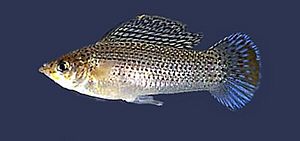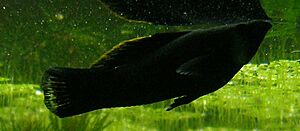Sailfin molly facts for kids
Quick facts for kids Sailfin molly |
|
|---|---|
 |
|
| Male | |
| Conservation status | |
| Scientific classification | |
| Synonyms | |
|
The sailfin molly (Poecilia latipinna) is a type of fish. It belongs to the Poecilia group. These fish live in fresh, brackish (a mix of fresh and salt), and salt waters. You can find them along the coasts from North Carolina to Texas and down to the Yucatán Peninsula in Mexico.
Contents
About the Sailfin Molly
The sailfin molly was first described in 1821 by a scientist named Charles Alexandre Lesueur. He studied fish from ponds near New Orleans, Louisiana. At first, there was some confusion about its name. Eventually, it was officially named Mollienesia latipinna. Later, scientists decided it belonged to the Poecilia group, so its full scientific name became Poecilia latipinna.
Names Around the World
The sailfin molly has different names in other languages. For example, in German, it's called Breitflossenkärpfling. In Norwegian, it's seilfinnemolly, and in Dutch, it's zeilvinkarper. In French, people might call it molly voile.
Sometimes, people confuse the sailfin molly with another fish called the Yucatan molly (P. velifera). This is because both fish have names that mean "sail" in some languages.
You might also see the sailfin molly sold in pet stores simply as "molly."
Where They Live
Sailfin mollies are found in freshwaters from North Carolina to Texas and the Yucatán Peninsula of Mexico. They really like marshes, slow-moving streams, swamps, and areas where rivers meet the sea (estuaries). They are very common in Florida.
These fish have also been introduced to new places. You can now find them in New Zealand, parts of the western U.S., and Hawaii. In some places, like California, sailfin mollies have caused problems for other native fish, such as the endangered desert pupfish.
Their Home Environment
Sailfin mollies usually hang out in shallow water. They like the edges of marshes, streams, ponds, and swamps. You might even spot them in temporary water bodies like roadside ditches. They often gather in groups under floating plants or near things in the water. This helps them hide from animals that might want to eat them.
These fish are very tough. They can live in places where there isn't much oxygen in the water. They do this by using their upturned mouths to breathe the thin layer of oxygen-rich water at the surface. Sailfin mollies can also live in different types of salty water. They can handle very salty conditions and even have their babies in brackish water.
Biology of the Sailfin Molly
Distinctive Features
The sailfin molly has a body shape that is mostly long and narrow. Its head is small and flat on top, with a little mouth that points upwards. The part of its body before the tail is wide, and its tail fin is large and rounded.
In adult males, the fin on their back (called the dorsal fin) is very big. It looks like a sail, which is how the fish got its name! This fin, along with their colorful tail, helps males attract females. Female sailfin mollies are usually bigger and not as colorful as the males.
The sailfin molly is smaller than the Yucatan molly (Poecilia velifera). You can tell them apart by counting the rays (spokes) in their dorsal fins. Sailfin mollies have less than 15 rays, while Yucatan mollies have 18-19. When a male sailfin molly spreads his dorsal fin, it forms a shape like a trapezoid.
Coloration
Most sailfin mollies are light grey. However, males ready to breed can look greenish-blue. They have rows of spots along their sides, back, and dorsal fin. Sometimes, these spots join together to form stripes.
People who keep aquariums have bred many different color types of sailfin mollies. You can find black, white, albino, and speckled versions. These color changes can also happen naturally in the wild.
Sailfin and Black Mollies
There is a completely black type of sailfin molly called the midnight molly. Sometimes it's just called a "black molly". The original "black molly" actually came from a different fish, Poecilia sphenops. Midnight mollies are actually hybrids, meaning they are a mix of the sailfin molly and P. sphenops.
It's easy for these two types of fish to mix their genes. Because the sailfin molly looks more impressive, especially the males with their large, yellow-edged dorsal fins, you often see these mixed sailfin-black mollies. These mixed fish can sometimes have unusual fin shapes. They can also breed with each other or with their parent species. They might not live as long as purebred fish, but they are generally healthy.
Size, Age, and Growth
Sailfin mollies usually don't live very long. Males, especially, might live less than a year after they can start having babies. They can start reproducing in less than a year, depending on their environment.
These are small fish. At one year old, males are usually about 0.5 to 3 inches long. Females are typically 0.5 to 2.5 inches long. The size of adult males can depend on how many fish are in the area. If there are more fish, the males tend to be smaller. The biggest sailfin molly ever recorded was about 6 inches long.
Diet
Sailfin mollies mostly eat algae and other plant materials. But they also enjoy eating small water creatures. This includes the larvae (young) of mosquitoes.
Reproduction
Sailfin mollies have internal fertilization. This means the male fertilizes the female's eggs inside her body. Males have a special fin called a gonopodium that helps them do this.
Female sailfin mollies give birth to live young. They can have anywhere from 10 to 140 babies at a time, depending on their size and age. Females can also store sperm for a long time after the male is gone. The babies grow inside the mother for about three to four weeks. A single female can give birth many times throughout the year.
Even though about half the babies born are male and half are female, there are usually more adult females in the wild. This is because males are more colorful and spend a lot of energy breeding. This makes them easier targets for predators and more likely to get sick. Sailfin mollies do not take care of their young after they are born.
Predators
Sailfin mollies are at the bottom of the food chain. Many different animals like to eat them. These include water insects, other fishes, reptiles, amphibians, birds, and even mammals. Some examples of their predators are giant water bugs, largemouth bass, American alligators, bullfrogs, snowy egrets, and raccoons.
Parasites
Like many animals, sailfin mollies can get parasites. One type of parasite is a tiny worm called Saccocoelioides sogandaresi. Another common parasite is a tiny organism called Ichthyophthirius multifiliis. This parasite causes a fish disease often called freshwater white spot or ich.
Importance to Humans
Sailfin mollies are very popular with people who keep aquariums. Many different color types are bred and sold in pet stores. Wild sailfin mollies are also sometimes used as feeder fish for larger fish that eat meat.
In nature, sailfin mollies help control mosquito populations. They do this by eating the young (larvae and pupae) of these pests.
Conservation
The International Union for Conservation of Nature (IUCN) has listed the sailfin molly as a species of "Least Concern". This means that it is not currently in danger of disappearing.
Images for kids
See also
 In Spanish: Poecilia latipinna para niños
In Spanish: Poecilia latipinna para niños




